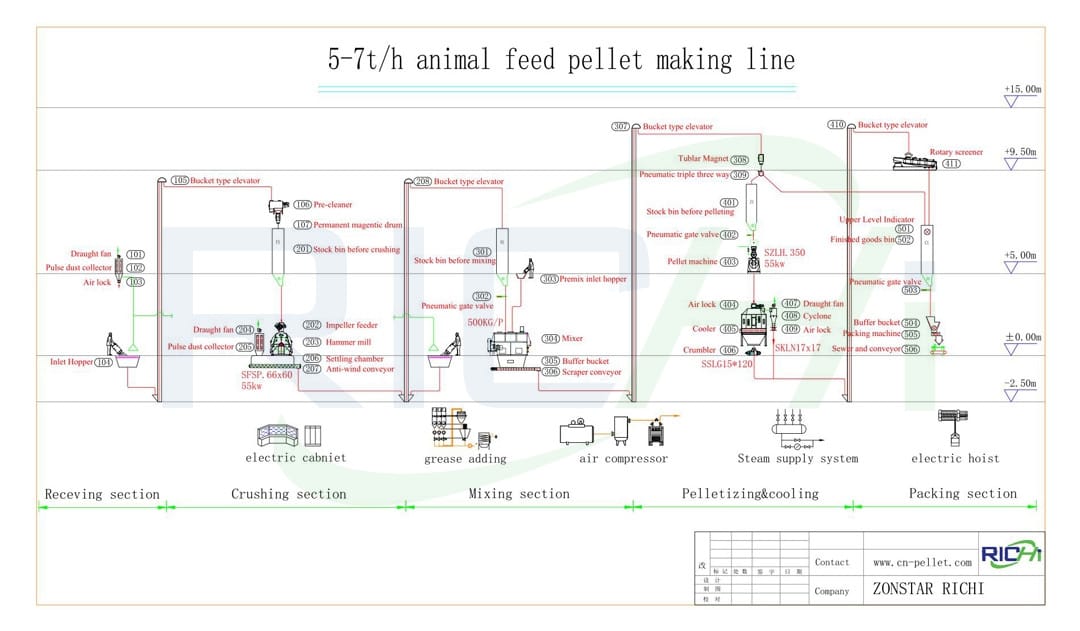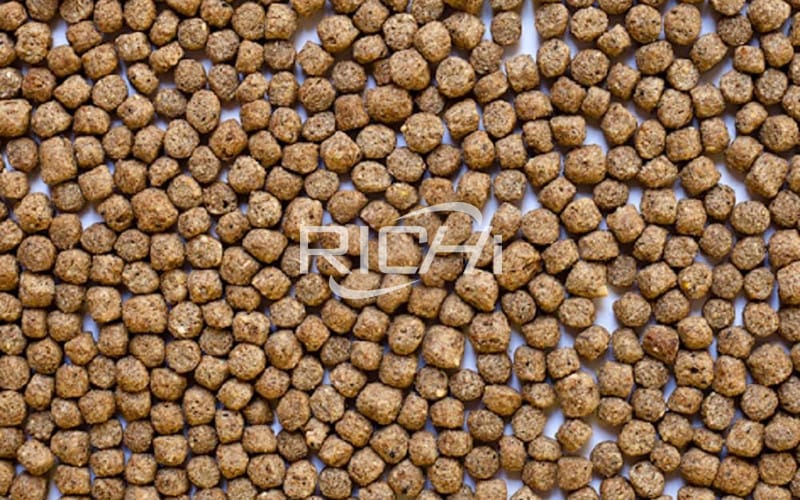What should we do if the animal feed has a high powder content?
In the process of animal pellet feed plant(the manufacturing process: cleaning -- crushing -- mixing -- pelleting -- cooling -- packing), the high powdering rate not only affects the feed quality, but also increases the processing cost accordingly, and has a certain impact on feed storage and transportation.

Then it is necessary to control the pulverization rate, first of all, the measurement of the pulverization rate. In general, animal feed processing plants take samples after the packaging process or stacking of finished products. Although the test results intuitively reflect the feed powdering rate, they cannot reflect the fluctuation factors of powdering rate in each process. Therefore, it is recommended to each process is effectively monitored, with prevention as the mainstay, and prevention and control as well. It is also recommended that the feed pellet production plant should determine the powdering rate before feeding the feed to the farmer, which represents the final powdering rate quality result.
The following is an analysis of each feed processing system:
1. Feed formula: Due to the different feed formulas of different varieties, the processing difficulty is different. Generally speaking, the feed with low crude protein and crude fat content is easy to be granulated and processed. On the contrary, the crude protein and crude fat content is relatively high,which will make it difficult to form after granulation, the feed pellets will be loose, and the pulverization rate is high. Comprehensive consideration of feed quality, formula is the premise, in the case of satisfying the nutrition ratio should try to consider the difficulty of granulation. In order to ensure the comprehensive quality.
2. Crushing system: The size of the feed crushing particle size directly affects the granulation quality. The smaller the particle, the larger the surface area per unit weight of the material. The better the adhesion during granulation, the higher the granulation quality. However, if the size of the crushing particles is too small, the cost of the crushing process will increase and some nutrients will be destroyed. How to choose different material crushing particle sizes according to comprehensive quality requirements and cost control is the key to laying a good foundation for the granulation process.
Recommendation: The size of powder before pelleting of livestock and poultry feed: above 16 mesh. Particle size of aquatic feed before granulation: above 40 mesh.

① First, tempering is the key. If the tempering is not sufficient, it will directly affect the granulation quality; its factors mainly include tempering time, steam pressure, steam temperature, etc., and the main indicators of the results are reflected in the tempering moisture and tempering temperature . Too low or too high conditioning water content, too low or too high conditioning temperature have a greater impact on the granulation quality, especially too low will make feed pellets not granulated tightly, the particle breakage rate and powdering rate increase, Not only affects the quality of the granules, but because of the anti-replication granules after screening, the processing cost is increased and some nutrients are lost.
Recommendation: Control the moisture content of tempering at 15-17%. Temperature: 70-90℃ (the steam entering the machine should be decompressed to 220-500kpa, and the temperature of the steam entering the machine should be controlled at about 115-125℃).
②The factors of granulation quality of ring die animal feed pellet mill include:
Select different ring dies according to different varieties. Some varieties with high protein and fat content require thickened ring dies.
During the operation, the material flow between the pressure roller and the ring die, and the temperature control of the material outlet have different degrees of influence on the granulation quality. The choice of pellet size and length is also worth considering.
It is recommended to control the discharge temperature to about 76-92℃ (too low the temperature of the machine will cause the insufficient curing of the feed and reduce the hardness of the pellets).
4. Cooling system: In this process, if the feed material is not cooled uniformly or the cooling time is too fast, the pellets will burst, causing the feed surface to be irregular and easy to break, thereby increasing the powdering rate.
5. Vibration classification screen:
If the grading sieve layer is too thick or unevenly distributed, it is easy to cause incomplete sieving, thereby increasing the powder in the finished product.
The pellet cooler machine is too fast to feed, and it is easy to cause the classification screen layer to be too thick, especially when the pellet size is ≤Φ2.5mm.
6. Finished product packaging process:
Since the finished product warehouse generally extends from the bottom of the factory floor to the bottom layer, and the drop is large, it is required that the finished product packaging process should be in the continuous production process. Falling down and breaking up causes the powder in the finished product to increase. This is especially true for materials with a high pulverization rate.
In summary, there are many factors that restrict the pulverization rate in the production process of pellet feed. Due to the different feed pellet formulas, equipment and processing techniques of each feed manufacturer, the control methods are also different, but the general manufacturers are all engaged in process operation control. Efforts should be made to control the process as much as possible to avoid the increase of the pulverization rate due to improper operation. However, if the feed powdering rate cannot be solved due to nutritional requirements or processing equipment process limitations due to certain varieties, it is required to consider the addition of binders to assist granulation to avoid high investment caused by large-scale equipment modification. In particular, aquatic feeds require the addition of binders due to their nutritional needs, physiological characteristics, and feeding characteristics to improve the quality of feed pellets and retention time in water.
If you want to know more about automatic animal feed processing machines,please feel free to contact Richi Machinery.
enquiry@richi-machine.com
Whatsapp/Cel: +86 185 7410 3366
If you want to built one complete pellet production line in your country, pls send the inquiry to us. We will customized design according to your requirement.



